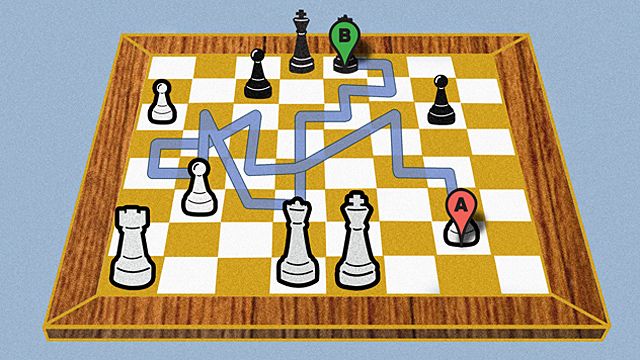Queens died prematurely in all of these miniatures.
The next one isn't easy: the loser of this game, GM Ratmir Kholmov, once beat Bobby Fischer brilliantly. The in-between move 11...Bxg2! takes a flight square away from White's king so that 12...Bb4+ can only be answered by 13.Qd2. And if White makes a normal move (12.Qd2 or 12.Nc5), Black just takes the free rook.
Black relied on the absolute pin in the game below when he played 11...Rd8?? But after 12.Qxd8+! Kxd8 13.O-O-O+, White unpins with check and wins back the queen with interest.
I apologize for the unfairness of the next problem! (But you did have the big hint that a queen hunt was involved...) The big pitfall to avoid was 12.Bxe7?? Nf3+! winning White's queen. But after 12.Be2!, White really is threatening 13.Bxe7, as well as 13.Bh5 trapping the Black queen, and there's no way for Black to stop both threats.
Accidents happen when the queen doesn't have Luft (chess players use the German word for "air" to mean an escape square or airhole). After 5.Bxf7! Kxf7 loses the queen after 6.Ng5+ Ke8 7.Ne6 or 6...Kf8 7.Ne6+, and 6...Kf6 7.Qf3 is mate. Patzers like you and me might choose to play on after 5...Kf8, but after 6.Ng5, White is up a pawn with a winning attack.
Whenever the queen and king are lined up on the e-file, look for tactics! 9.Qxe5+?? opened the e-file, and Black immediately took advantage with 9...Kd7!, clearing the way for the Ra8 to come to e8. The bishop on c1 was already hanging, and White has no way to answer both threats (10.Qc3 Re8+ and mate in one move).
If you've lost material out of the opening, and you're playing in London in 1940, you should keep calm, carry on, and trap the opponent's queen. Booth played 12.c3!, and Black has no way to escape, nor to stop 13.Nb3. Give yourself full credit if you chose 12.O-O! instead: 12...Qxd4 loses to the discovered attack 13.Bb5+, and 12...Bd7 13.Qb4 is overwhelming for White (or so Houdini tells me).
It is good to threaten mate and the queen at the same time! 12.Nd5! is a killer because 12...Qxd2 is answered by 13.Nc7 checkmate, and 12...Rxd5 13.Qxa5 wins because the poor knight on c6 doesn't really protect a5: it's pinned. The winner of this game, former U.S. Champion GM Arnold Denker, donated the money to fund the annual Denker Tournament of High School Champions.
You've already seen the Bxf7+! followed by Ng5+ & Ne6 queen suffocation idea. The only difference in this game is that Black could have responded to 7.Bxf7! Kxf7 8.Ng5+ with 8...Kg8. While the queen is not lost, checkmate on f7 is Black's fate after 9.Qb3+
This game was in Guinness for being the shortest game between two masters. 4.h3?? weakens White's defenses along the e1-h4 diagonal, and Black forces White to choose between loss of king or loss of queen:
Black was very brave to accept the Danish Gambit without the customary "return of gift" (3...d5!? or 5...d5!?). But 6...Bg4? lost a pawn to the standard 7.Bxf7+! trick, and 9...Nf6?? allowed a skewer:
Black was very brave to accept the Danish Gambit without the customary "return of gift" (3...d5!? or 5...d5!?). But 6...Bg4? lost a pawn to the standard 7.Bxf7+! trick, and 9...Nf6?? allowed a skewer:
The next one isn't easy: the loser of this game, GM Ratmir Kholmov, once beat Bobby Fischer brilliantly. The in-between move 11...Bxg2! takes a flight square away from White's king so that 12...Bb4+ can only be answered by 13.Qd2. And if White makes a normal move (12.Qd2 or 12.Nc5), Black just takes the free rook.
Black relied on the absolute pin in the game below when he played 11...Rd8?? But after 12.Qxd8+! Kxd8 13.O-O-O+, White unpins with check and wins back the queen with interest.
I apologize for the unfairness of the next problem! (But you did have the big hint that a queen hunt was involved...) The big pitfall to avoid was 12.Bxe7?? Nf3+! winning White's queen. But after 12.Be2!, White really is threatening 13.Bxe7, as well as 13.Bh5 trapping the Black queen, and there's no way for Black to stop both threats.
Accidents happen when the queen doesn't have Luft (chess players use the German word for "air" to mean an escape square or airhole). After 5.Bxf7! Kxf7 loses the queen after 6.Ng5+ Ke8 7.Ne6 or 6...Kf8 7.Ne6+, and 6...Kf6 7.Qf3 is mate. Patzers like you and me might choose to play on after 5...Kf8, but after 6.Ng5, White is up a pawn with a winning attack.
Whenever the queen and king are lined up on the e-file, look for tactics! 9.Qxe5+?? opened the e-file, and Black immediately took advantage with 9...Kd7!, clearing the way for the Ra8 to come to e8. The bishop on c1 was already hanging, and White has no way to answer both threats (10.Qc3 Re8+ and mate in one move).
If you've lost material out of the opening, and you're playing in London in 1940, you should keep calm, carry on, and trap the opponent's queen. Booth played 12.c3!, and Black has no way to escape, nor to stop 13.Nb3. Give yourself full credit if you chose 12.O-O! instead: 12...Qxd4 loses to the discovered attack 13.Bb5+, and 12...Bd7 13.Qb4 is overwhelming for White (or so Houdini tells me).
It is good to threaten mate and the queen at the same time! 12.Nd5! is a killer because 12...Qxd2 is answered by 13.Nc7 checkmate, and 12...Rxd5 13.Qxa5 wins because the poor knight on c6 doesn't really protect a5: it's pinned. The winner of this game, former U.S. Champion GM Arnold Denker, donated the money to fund the annual Denker Tournament of High School Champions.
You've already seen the Bxf7+! followed by Ng5+ & Ne6 queen suffocation idea. The only difference in this game is that Black could have responded to 7.Bxf7! Kxf7 8.Ng5+ with 8...Kg8. While the queen is not lost, checkmate on f7 is Black's fate after 9.Qb3+






































